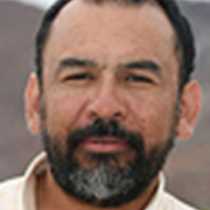Boca de la Soledad & Hull Canal, Magdalena Lagoon
A magnificent calm, emerald green-colored Magdalena Lagoon was unveiled before our eyes after the sunrise this morning, when at 7:00 we started our second day of gray whale watching at Boca de la Soledad. Along with this, a lot of birds, but mainly double-crested cormorants, flew in certain directions to form the huge concentrations that we have already been observing during the last few days. The wind blew weakly and allowed us to promptly find whale blows.
As we approached with our Zodiac boats to Santo Domingo Island we began to find pairs of mother whales and calves traveling slowly against the incoming strong tidal current. We followed the pairs and observed a lot of their normal behavior that included rolling on their sides, calves’ breaching and mothers’ spy hopping. Sometimes the baby whales were taught to scoop up the muddy bottom, and several times we saw the mud coming out of their open mouths when they reached the surface to breathe. Eventually everybody on board the Zodiac boats found solitary whales traveling in search of mates, or going, for few minutes, around the scattered pairs of caws and calves, like investigating for potential mates. On our return to the National Geographic Sea Bird we stopped to see frigate birds and more nesting cormorants perched on dense patches of red and white mangroves.
During lunch we pulled up anchor and navigated southbound in the narrow Hull Canal. At a beautiful locality just few miles north of Puerto San Carlos, we anchored again and organized Zodiac cruises, as well as a round of kayaking, among the fabulous mangrove community. The tide at that time had gotten to its lowest point so we were able to observe the intricate root system of the red and white mangroves that support a variety of wildlife. These root systems are otherwise completely submerged during high tides. Amongst the animals that were seen perching above or hiding into the mangroves, were yellow-crowned night herons, white ibises, great blue herons, scrub jays and great egrets. On the sand and mudflats there were marbled godwits, whimbrels, willets and other shorebirds very busy picking up a great diversity of marine invertebrates that constitute their food. We also picked up oysters, chocolate clams, pen shell, and swimming crabs, not to eat them but to observe the impressive and stylish structures of their bodies.
Our unforgettable experience of navigating, walking, kayaking, snorkeling and exploring in the Sea of Cortes, the area of Los Cabos, Gorda Banks, the Pacific side of the peninsula of Baja California, Magdalena Lagoon, and several islands finished with a sunset over the waters of the extensive Pacific Ocean with blue, green, yellow, orange, red and pink colors that resembled those from an artist’s palette.
A magnificent calm, emerald green-colored Magdalena Lagoon was unveiled before our eyes after the sunrise this morning, when at 7:00 we started our second day of gray whale watching at Boca de la Soledad. Along with this, a lot of birds, but mainly double-crested cormorants, flew in certain directions to form the huge concentrations that we have already been observing during the last few days. The wind blew weakly and allowed us to promptly find whale blows.
As we approached with our Zodiac boats to Santo Domingo Island we began to find pairs of mother whales and calves traveling slowly against the incoming strong tidal current. We followed the pairs and observed a lot of their normal behavior that included rolling on their sides, calves’ breaching and mothers’ spy hopping. Sometimes the baby whales were taught to scoop up the muddy bottom, and several times we saw the mud coming out of their open mouths when they reached the surface to breathe. Eventually everybody on board the Zodiac boats found solitary whales traveling in search of mates, or going, for few minutes, around the scattered pairs of caws and calves, like investigating for potential mates. On our return to the National Geographic Sea Bird we stopped to see frigate birds and more nesting cormorants perched on dense patches of red and white mangroves.
During lunch we pulled up anchor and navigated southbound in the narrow Hull Canal. At a beautiful locality just few miles north of Puerto San Carlos, we anchored again and organized Zodiac cruises, as well as a round of kayaking, among the fabulous mangrove community. The tide at that time had gotten to its lowest point so we were able to observe the intricate root system of the red and white mangroves that support a variety of wildlife. These root systems are otherwise completely submerged during high tides. Amongst the animals that were seen perching above or hiding into the mangroves, were yellow-crowned night herons, white ibises, great blue herons, scrub jays and great egrets. On the sand and mudflats there were marbled godwits, whimbrels, willets and other shorebirds very busy picking up a great diversity of marine invertebrates that constitute their food. We also picked up oysters, chocolate clams, pen shell, and swimming crabs, not to eat them but to observe the impressive and stylish structures of their bodies.
Our unforgettable experience of navigating, walking, kayaking, snorkeling and exploring in the Sea of Cortes, the area of Los Cabos, Gorda Banks, the Pacific side of the peninsula of Baja California, Magdalena Lagoon, and several islands finished with a sunset over the waters of the extensive Pacific Ocean with blue, green, yellow, orange, red and pink colors that resembled those from an artist’s palette.




